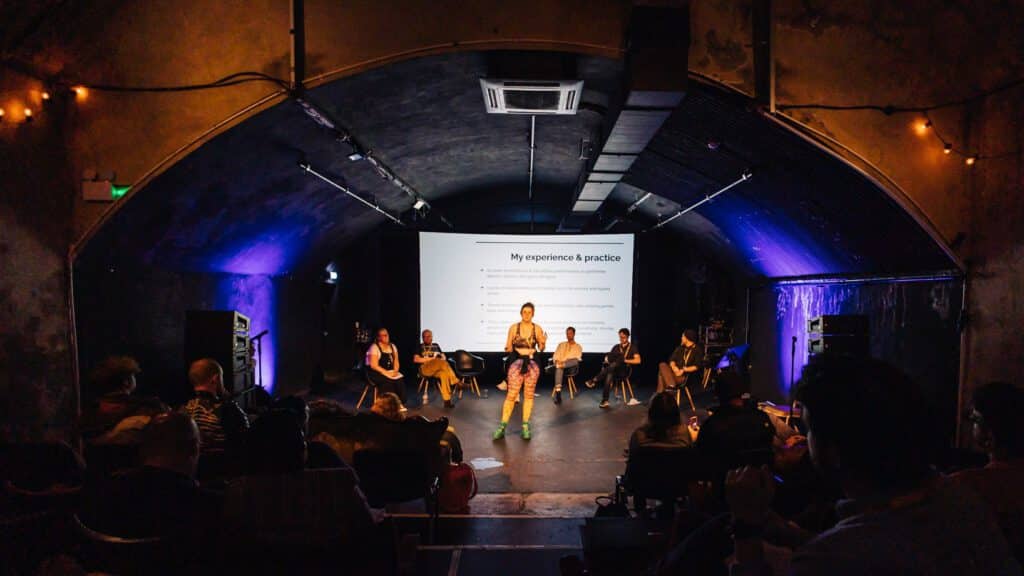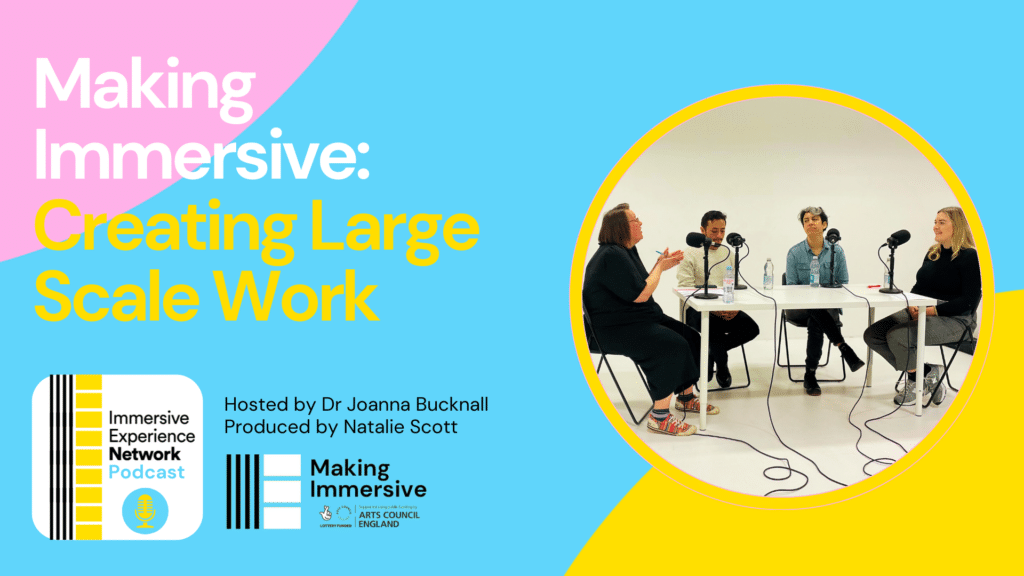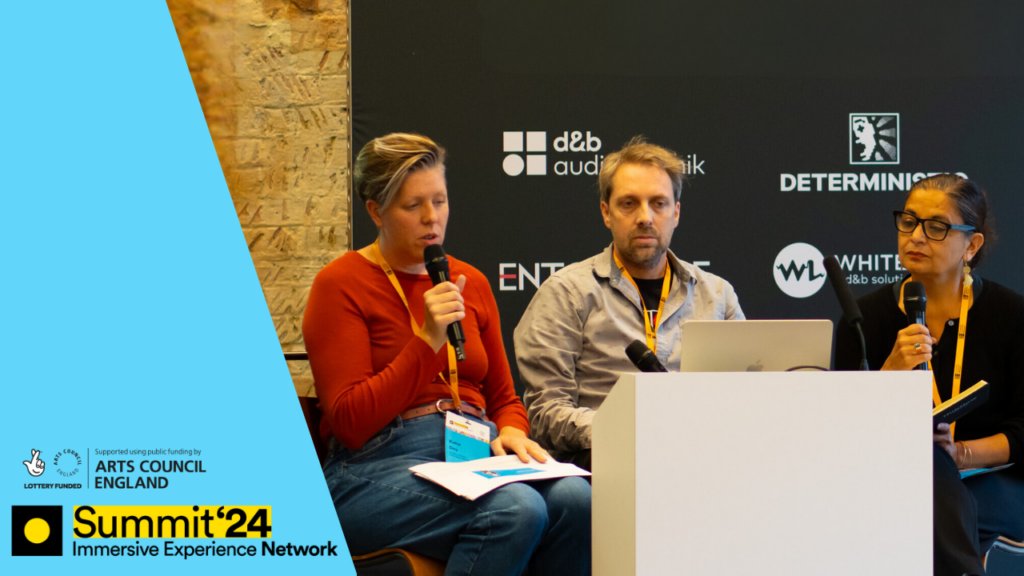In his opening address, Owen Kingston of interactive creators Parabolic Theatre posed the question about how to keep audiences coming back to immersive shows. “If we just keep trotting out the same stuff, it’s going to get dull,” he said.
And as Rob Morgan of immersive AR group Playlines noted, it is hard to reinvent the wheel. “Narratively speaking, there’s nothing new under the sun including immersive because none of that stuff is really new.”
So what is the future of the immersive sector? And how do you keep audiences coming back? That was the hot topic for the final talk of the day at the Immersive Experiences Summit – which ranged from a need to invest more in actors, to a discussion about the pros and cons of technology – and the divisive issue of NFTs.
Owen Kingston and Rob Morgan were joined by Hamish A Jenkinson of immersive agency The Department, Pip Brignall of The Round – the first Web 3.0 platform for live entertainment in Augmented Reality (AR) – game and theatre maker Chloe Mashiter and Dr Jorge Lopes Ramos who works in art, technology, games and social impact. The talk was moderated by Dr Joanna Bucknall, from the department of Drama & Theatre Arts at Birmingham.
Before the discussion moved on to technology, Owen Kingston spoke about actors being the lynchpin of the performing arts – and how more needed to receive specific training for immersive work.
He said: “I love actors. I am hopeful for the future that we honour our actors better. And that we grow a strong training methodology, and we raise up people who have skills. One of the things I want to see is raising people up who can make this kind of work distinct from conventional theatre, we shouldn’t just be casting people from drama schools that we like and hoping for the best.”
In his opening speech, Pip Brignall spoke about making technology and shows with Virtual Reality (VR) and AR elements accessible to all audiences.
“The obstacles to using this technology […] is accessibility and affordability and distribution,” he said. “It’s a matter of how accessible this technology is to this industry, to everybody right here. But also to audiences in terms of distribution. [For example] You know, if you create an amazing VR experience, you’re limited to people who have a VR headset. [Generally] there’s so many boundaries.”
Rob Morgan agreed. “That’s why we have to make sure that the technology and the conversation is inclusive and accessible to the marginalised. Now, there’s a real danger that these technologies will end up pushing marginalised people further out of sight to those who don’t want to see them.”
It was Pip Brignall who was the first to bring up NFTs in his opening address. NFTs – or non-fungible token – are a digital asset that represents an object, typically a piece of art, that is bought and sold online using cryptocurrency. In the past two years, the prominence of NFTs, and their value, has exploded.
He said: “I think that the world of Web3 (the third generation of the internet based on the philosophy that the internet should be a decentralised network of computers) and NFTs has demonstrated how powerful online communities can be and you would ignore that at your peril.”
And when a question came in from the floor about the potential of NFTs and what they could mean for the future of immersive, Pip Brignall continued: “I personally think that NFTs are incredibly powerful. I think that we’ve only scratched the surface of what the technology that underpins NFTs can and will do. There’s a lot to be explored, and I don’t have the answers. We’ve definitely started exploring what we can do.”
However, Chloe Mashiter highlighted how divisive NFTs are. There is little regulation over NFTs, and as they are bought using cryptocurrency, they have substantial environmental impact.
Chloe Mashiter said: “I know a huge number of artists who will not work on any project that involves NFTs. I am included in that. I personally don’t think there’s anything incredible that we can do with NFT’s that we can’t somehow achieve without them. And for me, the environmental impacts, the energy impact, the imbalance of wealth within the crypto sphere – it’s even more imbalanced than physical fungible money. And for me, that’s why I would prefer a future that doesn’t feature them.”
She later added: “I don’t know, I really struggled to get on board with the notion [that this is] what evolution looks like. This is what progress looks like. I’m interested in versions that don’t look like that, personally.”
Hamish Jenkinson said despite obvious problems with NFTs, there were positives. “But fundamentally, the ideas behind all of these movements are not bad ideas, they’re good ideas. They’re trying to make the world a better place. Whenever there is an opportunity to exploit, certain members of our society try to do that. But it doesn’t mean that the underlying technology is not actually going to have a fundamental positive impact on our lives.”
Moderator Dr Joanna Bucknall posed a question about how fast technology moves – and how perhaps there was a “responsibility” to think about what to do with these “piles of obsolete things.”
Owen Kingston said: “Somebody earlier on one of these panels who loved Star Trek pointed out that utopian vision of a future where technology is an asset and assists us cannot be arrived at without an awful lot of waste, an awful lot of expenditure. And if we want to have a positive vision of our future that involves technology, then we do also need to do perhaps some harmful things to get there. We didn’t get to the moon without spending an awful lot of money and burning an awful lot of rocket fuel.”
Despite the pitfalls of technology, Hamish Jenksinson said technology had the potential to revolutionise the immersive sector.
“I think what’s incredibly exciting is the way that we’re going to use technology to redesign immersive experiences,” he said. “I’m lucky I get out and about, I see a lot of stuff, some stuff that not many people get to see. [I have seen a] little glimpse of the amazing blended reality that I think is coming, and is going to make the kind of experiences that we create the most cutting edge, the most desirable, and most incredible.”






